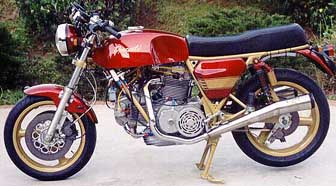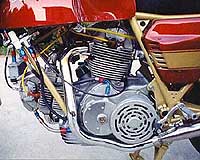

"There is no actual year to my Ducati."
Kevin Bracken
Originally my Ducati was a race bike.
It went through a number of changes and major revisions.
At the end of my racing days the bike had morphed into
a 750 Sport.
At the end of 1984 my friend and I decided to build
a bike based on the ones we had both raced, using mine
as a starting point.
We had visions of being sponsors with a rider, not
fully realizing the problems and costs that entailed.
Looking back I am amazed at our naivete'.
click image for larger view
Originally my Ducati was a race bike that I campaigned in AFM, ARRA and AMA Battle of the Twins series from 1979-1984. It went through a number of changes and major revisions. At first it was a Darmah, simply because putting two crashed bikes together was the cheapest way to go.
At the end of my racing days the bike had morphed into a 750 Sport frame and the usual glasswork associated with SS bikes. Along the way I won a few California club season championships in various classes and one National BOTT race and placed a number of times in BOTT nationals at Daytona, Sears Point, Laguna Seca and Elkhart Lake. At the end of 1984 my friend and fellow racer, Tony Guest, and I, decided to build a bike based on the ones we had both raced, but using mine as a starting point.
We had visions of being sponsors with a rider, not fully realizing the problems and costs that entailed. Looking back I am amazed at our naivete'.
The main project goal was more power. Jim Woods had introduced me to CR Axtell somewhere in my first season of racing and in the succeeding years Ax and I developed a strong friendship. Axtell is very well known in dirt track racing circles and just a wonderful human being. He aided me with much in the way of piston design and port work during my racing and was willing to help us on our project. The late Dale Newton and I had also developed a friendship as well during this time. He was among the nicest people I have ever known. Dale fortunately had many contacts at the factory. Through Sr. Valentini, Dale was able to get a print of the heads for me and, as Axtell requested, some heads right off the assembly line, prior to any port work. Ax felt this was very important because he maintained that the Italians, although builders of beautiful machinery and wonderfully efficient engines, could not design a port to save their lives. He always thought the bevel made more power from "the wristpin on down" than any other engine he had worked with.
With the aid of the print and MANY hours on the flow bench using an old belt drive head (60 angle instead of 80 degrees for the valves is a big advantage), we were able to increase the flow by a factor of two compared to the best 80 degree bevel drive heads. This involved reangling the valves, filling in the ports with weld and completely recontouring the port shape. At the end the ports flowed almost as good as a Harley XR750 flattrack dirt racer, about the best two valve head around. We made a set for our bike and a set for Dale Newton's F1-750. I used the efforts of Frank Neimeyer (world's greatest welder, he's the guy that filled in the ports without distortion) to graft on some weld and then machined the heads to accept the bevel drive mechanism. As usual, Ax helped me with the piston design on the dome and I had JE Pistons make a few sets.
  click for larger view click for larger view
Dyno testing was a bit frustrating. The best power we had ever had out of a bevel drive was 85 at the rear wheel on Axtells dyno with a very broad power band. The engine with the new reworked heads made 92 tops, but it was apparent that there was serious blow-by. Ax said if we could solve the blow-by problem that the engine should make 100 HP, based on flow bench numbers and predictive calculations that he had worked up from years of doing this sort of thing. We raced it in BOTT anyway at Sears Point, using Rich Oliver. He was in second about three laps from the end and the crank sheared on the drive side. The next race at Laguna Seca, Danny Coe finished second behind John Williams on Dale Newton's bike. But ours was still not sealing the rings. Not long after that my normal job as an engineer in the pharmaceutical industry got way too time consuming and I had to more or less abandon the project and come back to it only when time allowed.
Years later after having the bike sit untouched, I finally found the time and desire to get it right. Ax and his partner Mike Libby consulted. The first thing I had to accept was that I couldn't handle clip-on bars anymore. Fortunately I had owned a '74 GT750 for 110,000 miles and loved that bike. I decided that I would make a "modern" knockoff. That way I could carry my wife or one of my kids should the occasion arise. But the engine would be vastly more powerful than the 750's.
The bike is immensely strong, sounds fabulous and rides pretty damn well for a modernized bevel. I absolutely love it.
Forks are from a 1988 Yamaha FZR 750 roadracer, courtesy of Tony Guest's contacts with Yamaha at the time, with RaceTech emulator internals and lighter springs.
Shocks are Ohlins, originally setup by Bruce Burness, the designer of the shocks and a friend of Axtell's.
(I swear, he seems to know everybody!)
Frame is a 750 Sport frame with the centerstand support plates remanufactured and welded on by Rob North.
Headers made by Rob. They are tucked in compared to stock due to a crash because stock pipes didn't work for racing.
Rear footpeg muffler mounting tubes, customized and attached by Rob.
Wheels are magnesium Marvics. The front is a 17 inch and the rear is an 18 inch from a Honda 500 road racer circa 1983 or so.
Brakes are AP. Even though only dual piston calipers, they are very strong.
Tank, covers and rear fender are from Syd's Cycles.
Front fender is from a Honda Nighthawk or Shadow, can't remember which.
Bars are from Pro Italia, courtesy of Earl Campbell.
Paint design and application is by Len Lochmiller, a true artist, local in San Diego. He also widened the rear fender and made a seat pan and tool tray out of fiberglass.
Wiring - I did it myself.
Swingarm is custom made box section from some guy that Tony Guest knew in the East. However it flexed too much, so Bruce Burness added 1/2 pound of sheet metal in the right places and increased the torsional rigidity by a factor of 3! A wizard! The swing arm was originally made 18 inches long. The bike has some very un-Ducati-like wiggle in high speed sweepers, which I have tried many combinations of shock length and fork position to solve. Malcolm Tunstall has been very helpful there. I am going back to the 19 inch swingarm. Rob North is doing that.
|
 
Engine: 905 cc with 88 mm JE pistons (my own dome), S-2 cylinders, 12:1 CR, (actual measurement).
Heads have been described in my article.
Crank has plain bearing Carillo rods from Axtell's flattrack engine projects, with my own pin design.
click for large view
|
Oil pump is speeded up with gears from Albert Bajohr of Germany, one of the earliest guys to try a plain bearing conversion. Flow to the heads is restricted with carburetor jets at an external manifold. The drain lines from the heads to the sump prevent oil from landing on the crank counterweights. This allows the engine to rev more quickly, reducing the water wheel effect. That change is fairly easy to do. Pressure feed is out of the engine from the factory cast-in boss, located in-between the front cylinder and tower drive tube, up to an externally mounted oil filter, down to a cooler and then to a distribution manifold with appropriate orifices. I try to hold oil pressure at 70 psi at full speed. My article has more detail on this.
Transmission is one of the original "Webster" gearboxes, made by Chis Warmuth. It is made from 9310 steel, pretty good stuff. Very fine work on the gears. One of the hardest things was getting a kickstarter gear made, since this gearbox does not match the teeth of the original in any way. Fortunately, I managed to get that done locally in San Diego. I screwed up in not grinding off all of the half-height dogs on the gears. Recently the bike started missing shifts from 4th to 5th. I am having the damaged dogs reground by a local tool grinder.
Meanwhile, Brook Henry sold me one of his 3 dog gearboxes.
Clutch is Vee-Two. It comes with the vented cover. The wet clutch would not work because of the power, regardless of Barnett clutch material or spring combinations. Even slipping, the engine made 66 ft-lbs torque on the dyno at 6000 rpm. The Vee-Two clutch worked OK for about 3000 miles, then slipped. Shimming the springs gave another 1000 miles. It wore out the friction disks completely in 4500 miles. Brook Henry recommended some Barnett Kevlar clutch plates and heavy-duty springs to fix that. I have the new plates and am talking to Barnett about heavier springs. The clutch actuator arm is lengthened 1 inch to improve leverage for heavier springs. This is an old Jim Woods trick. However with the heavier-to-come springs I may have to go with the hydraulic conversion that Ivan Thelin has recently talked about from Karl Engellenner in Sacramento. I play the piano a lot, so my hands are unusually strong. We'll see.
Headers are 1-3/4 inch with Axtell 27-inch megaphones and a Supertrapp muffler to try to cut the noise somewhat. The bike is loud.
Carburetors are 40 mm Dellortos, with lengthened manifolds and big K&N filters. Got to protect those expensive heads.
Ignition is Lucas-Rita to get only one spark on the compression stroke. Timing is at 36 degrees.
Instrument panel is my own design to put the tach up front. I cut it out with my drill press. I am not sure about it. I keep toying with going with a more traditional arrangement, but that can wait.
My experiences building a 900 race motor - Kevin Bracken
|
B A C K
|
|